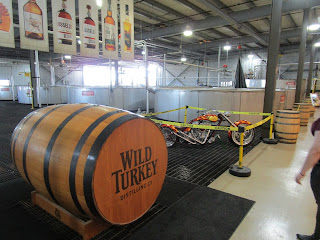 |
| I'm at a bourbon distillery. I can't remember which one. I had HOW MANY glasses in the tasting room? |
It is right along the banks of the Kentucky River, which flows into the Ohio, which flows into the Mississippi, which flows out into the world. The water of the Kentucky River also has a high limestone content, which improves the "sweetness" of the water.
The Wild Turkey distillery was started by an Irish gentleman who had experience making whiskey back in Ireland.
Although the Wild Turkey distillery is a large scale operation, the tour on a Monday would not be the rush hour traffic that I saw on Saturday at the smaller-scale Woodford Reserve distillery in nearby Versailles (pronounced, of course, ver-SALES because this is America).
Wild Turkey is made with a combination of corn, rye and malted barley. Our tour guide told us that Wild Turkey bourbon has a higher rye content relative to other bourbons and that Wild Turkey rye has a higher corn content than other rye whiskeys. This is the proportion:
Rye is likely the same proportions, with the corn and rye components switched.
Since 2009, Wild Turkey has been owned by Italy's Campari group. They just need to add a vermouth bottler, since bourbon and Campari, along with sweet vermouth, are the ingredients to make the premier cocktail among cocktails: the boulevardier.
And here's what I learned. Whiskey is basically distilled beer.
They make a slurry of cereal grains and water, then add yeast to let it ferment. Basically, become beer.
The beer is then distilled.
And it becomes whiskey. This is the quality control room, to make sure that the bourbons and ryes are on track to where they are supposed to be, taste-wise.
And this is where it all becomes bourbon: aged in oak barrels, with the insides charred to a lizard-like texture.
They are packed away to age. Part of what makes Kentucky perfect bourbon making country is that the temperature extremes maximize the interaction of the alcohol with the charred barrels. You don't want only cold or only heat. You want the temperatures oscillating wildly.
And from there we are whisked off to the tasting room. "Whisked" off. For some "whiskey." I amuse myself.
With a lovely view of the Kentucky River valley.
We are presented five bourbons to sample. The first, moving left to right, is the standard best-selling 101. This is the drink you think of, when you think of Wild Turkey.
Second, is the Single Barrel Russell's Reserve, which actually has a bit of "creaminess" because of a tiny fat content. It coats the tongue. The third is Rare Breed. The fourth is ... well, I don't remember what the fourth one was ... maybe a rye of some sort. And the fifth was Wild Turkey's "Honey Sting," a honey liqueur with a hint of ghost pepper. And only a hint. It brings a little heat to cut the sweetness of the honey, but it's not overpowering. Our tour guide says the "Honey Sting" is the best chicken marinade you could ever use.
And the winner was the one I bought a bottle of in the gift shop since I've not seen it for sale at my local Lee's Discount Liquor: The Russell's Reserve Single Barrel bourbon whiskey.

















No comments:
Post a Comment